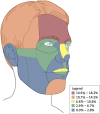Electric scooter craniofacial trauma
- PMID: 32596481
- PMCID: PMC7314474
- DOI: 10.1002/lio2.380
Electric scooter craniofacial trauma
Abstract
Objective: The use of standing electronic scooters associated with micromobility applications (e-scooters) has risen nationally. The aim of this study was to obtain a detailed view of soft tissue and bony craniofacial injury associated with e-scooter-related trauma.
Methods: Single-institution retrospective case series of patients presenting to a level 1 trauma center emergency department or trauma unit with documented e-scooter-related craniofacial injury.
Results: Of 203 included patients, 188 (92.6%) patients sustained craniofacial injury. One hundred thirty-one (64.5%) had exclusively soft tissue injury, 3 (1.5%) exclusively bony injury, 51 (25.1%) both soft and bony injuries, and twenty-five (12.3%) patients sustained dental injury. Aesthetic units most frequently sustaining acute soft tissue injury were the forehead (n = 106, 34.6%), scalp (n = 36, 11.8%), chin (n = 34, 11.1%), upper lip (n = 32, 10.5%), and cheek (n = 31, 10.1%). Aesthetic subunits most often sustaining acute soft tissue injury included the brow (42, 13.7%), central forehead (39, 12.7%), lateral forehead (n = 25, 8.2%), and upper lip vermillion (n = 23, 7.5%). Craniofacial osseous fracture most often occurred in the orbit (n = 42, 24.6%) and maxilla (n = 40, 23.4%). Individual osseous segments most frequently sustaining acute fracture included the anterior maxillary sinus wall (n = 22, 12.9%), nasal bone (n = 20, 11.7%), lateral orbital wall (n = 16, 9.4%), orbital floor (n = 15, 8.8%), and zygomatic bone (13, 7.6%).
Conclusions: Our analysis demonstrates that most patients presenting to our center with craniofacial trauma sustained acute bony fracture, most often to the midface. Our data of common injuries associated with e-scooter trauma could inform implementation in the form of facial safety equipment or safety skills training for e-scooter riders.
Level of evidence: 4.
Keywords: craniofacial; electric; face; head; scooter; trauma.
© 2020 The Authors. Laryngoscope Investigative Otolaryngology published by Wiley Periodicals, Inc. on behalf of The Triological Society.
Conflict of interest statement
The authors declare no conflicts of interest.
Figures
References
-
- Bird Rides Inc . Santa Monica Mobility Pilot Program; 2018.
-
- Hall M. Bird Scooters Flying Around. Santa Monica: CA, Santa Monica Daily Press; 2018.
-
- Dickey MR. The Electric Scooter Wars of 2018. Bay Area: California, Techcrunch; 2018.
-
- Shared Micromobility in the U.S.: 2018; 2019. https://nacto.org/shared-micromobility-2018/
-
- Namiri NK, Lui H, Tangney T, Allen IE, Cohen AJ, Breyer BN. Electric scooter injuries and hospital admissions in the United States, 2014‐2018. JAMA Surg. 2020. https://jamanetwork.com/journals/jamasurgery/fullarticle/2758159 - PMC - PubMed
LinkOut - more resources
Full Text Sources
Research Materials


